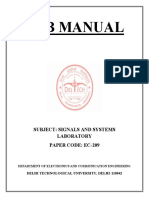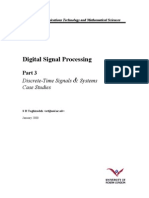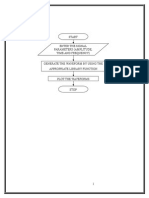Matlab Discrete Time Lab 2
Uploaded by
Emmylyn Roma RoqueMatlab Discrete Time Lab 2
Uploaded by
Emmylyn Roma RoqueBulacan State University College of Engineering Ece 441L: Signal, Spectra and Signal Processing Lab Name: _________________________________
Date: ___________________ ECE 4___ Comp No. ___
Exercise No. 2: MATLAB Discrete-Time Signal 2 Objectives: In this Exercise you will learn to: 1. Create MATLAB functions of signals 2. Create MATLAB functions of signal manipulations 3. Apply the created MATLAB functions to perform DiscreteTime Signal Processing. Signal Addition 1. Copy the commands in Figure 5. You may omit the comment to shorten the typing process. 2. Save the function to your created folder in the document file and name the function as sigadd. 3. Close the Editor Window. 4. From the command window, the current directory must be the folder name you created. 5. The following signals will be used for signal addition.
x1 (n) ={2,2,2,0,1,2,3,4} x2 ( n) ={1,0,1,2,3,4,4,4,4,4}
&
6. Copy the following command to represent the signal x1(n) in MATLAB: n1=[-3:4]; x1=[2 2 2 0 1 2 3 4]; [n1;x1] % to view table of x1 wrt time n1
7. Now, create command for signal x2(n). Note: Use n2 for the time variable of x2(n).
8. To perform the signal addition:
y1 (n) = x1 ( n) + x2 (n)
Type the following command: [y1, ny1]=sigadd(x1,n1,x2,n2); 9. Write the answer in the space provided.
Signal Multiplication 10. Click New button, then copy the commands in Figure 6. Save it as sigmult. 11. Using the value of x1(n) and x2(n), the following command can be used to multiply the two signals: [y2, ny2]=sigmult(x1,n1,x2,n2); 12. Write the answer in the space provided.
Amplitude Scaling
13. If were going to implement the equation: 3 x1 ( n)
[n1;3*x1] 14. Write below the answer for this command.
15. Write the command for this equation. Clue: use amplitude scaling for negative amplitude.
y 4 ( n) = x1 ( n) x2 (n)
16. Write below the answer for this command.
17. Lets practice signal addition, multiplication and amplitude scaling. Below are the functional representations of the two inputs.
2 for 2 n 1 x3 (n) = 1 for 2 n 4 0 otherwise
1 for 3 n 0 x4 (n) = 2 for 3 n 5 0 otherwise
18. Write below the commands for representing the two inputs and their time n. Note: Use n3 for the time variable of input x3 and n4 for the time variable of input x4.
19. Write the command for this equation.
y5 (n) = 2 x3 (n) 3 x4 (n)
20. Write below the answer for this command.
21. Write the command for this equation.
y6 (n) = x3 ( n) * x4 ( n) + 2 x2 (n)
22. Write below the answer for this command.
23. Write the command for this equation.
y6 (n) = x1 (n) + x2 (n) 2 x3 (n) + x4 (n)
24. Write below the answer for this command.
You might also like
- Lab 0: Introduction To MATLAB: (LABE 410) Dr. Jad Abou ChaayaNo ratings yetLab 0: Introduction To MATLAB: (LABE 410) Dr. Jad Abou Chaaya6 pages
- Signals and Systems - DR - Dr. R. AnjanaNo ratings yetSignals and Systems - DR - Dr. R. Anjana54 pages
- Signals and Systems - DR - Dr. R. AnjanaNo ratings yetSignals and Systems - DR - Dr. R. Anjana54 pages
- Introduction To Discrete-Time Signals: InstructionsNo ratings yetIntroduction To Discrete-Time Signals: Instructions14 pages
- Digital Signal Processing Lab - DR - R KumaraswamyNo ratings yetDigital Signal Processing Lab - DR - R Kumaraswamy56 pages
- Computer Assignment 1 19ECE203 Signals and SystemsNo ratings yetComputer Assignment 1 19ECE203 Signals and Systems3 pages
- (BL - EN.U4ECE22022) Sandeep-Signals and Systems AssignmentNo ratings yet(BL - EN.U4ECE22022) Sandeep-Signals and Systems Assignment27 pages
- Lab 02A-Signals and Wave Form Generation: ObjectivesNo ratings yetLab 02A-Signals and Wave Form Generation: Objectives8 pages
- Discrete Time Signals and Signal Operations: DSP Lab#03No ratings yetDiscrete Time Signals and Signal Operations: DSP Lab#034 pages
- Laboratory 1: Discrete-Time Signals in MATLABNo ratings yetLaboratory 1: Discrete-Time Signals in MATLAB8 pages
- Objective: % Time (Sampling Freq - 10 HZ) % Amplitude % Frequency % The Command y (Y 0) 0 Removes - Ve ValuesNo ratings yetObjective: % Time (Sampling Freq - 10 HZ) % Amplitude % Frequency % The Command y (Y 0) 0 Removes - Ve Values2 pages
- Generating Discrete Time Signal, Performing Various Operations and Convolution of Discrete Time SignalsNo ratings yetGenerating Discrete Time Signal, Performing Various Operations and Convolution of Discrete Time Signals3 pages
- Labsheet-1: Question No.1:Basic Signal Generation and PlottingNo ratings yetLabsheet-1: Question No.1:Basic Signal Generation and Plotting15 pages
- Digital Signal Processing - DR - Prarthan MehtaNo ratings yetDigital Signal Processing - DR - Prarthan Mehta61 pages
- Exercise No. 1: MATLAB Discrete-Time Signal Objectives:: Unit Sample SequenceNo ratings yetExercise No. 1: MATLAB Discrete-Time Signal Objectives:: Unit Sample Sequence4 pages
- Digital Signal Processing Lab Manual UpdatedNo ratings yetDigital Signal Processing Lab Manual Updated85 pages
- Digital Signal Processing - Ms - E. Sangeetha DeviNo ratings yetDigital Signal Processing - Ms - E. Sangeetha Devi47 pages
- Digital Signal Processing: BY:-Ankit Sharma Roll No: - 0657013108 Btech (It)No ratings yetDigital Signal Processing: BY:-Ankit Sharma Roll No: - 0657013108 Btech (It)33 pages
- Digital Signal Processing - Ms - E. Sangeetha DeviNo ratings yetDigital Signal Processing - Ms - E. Sangeetha Devi52 pages
- A Brief Introduction to MATLAB: Taken From the Book "MATLAB for Beginners: A Gentle Approach"From EverandA Brief Introduction to MATLAB: Taken From the Book "MATLAB for Beginners: A Gentle Approach"2.5/5 (2)
- Cmo 24, S. 2008 - Approved Ps For The Bs Ece V 2No ratings yetCmo 24, S. 2008 - Approved Ps For The Bs Ece V 216 pages
- Exercise No. 3: Shapes Operations and Stencil Creation: Bulacan State University College of Engineering100% (1)Exercise No. 3: Shapes Operations and Stencil Creation: Bulacan State University College of Engineering7 pages
- CMO 24, S. 2008 - Annex 1 - Core Competencies For ECENo ratings yetCMO 24, S. 2008 - Annex 1 - Core Competencies For ECE2 pages
- Condition Monitoring of A Turbfan Engine - NCMAPSSNo ratings yetCondition Monitoring of A Turbfan Engine - NCMAPSS46 pages
- Getting Started With Simulink: An Introductory TutorialNo ratings yetGetting Started With Simulink: An Introductory Tutorial47 pages
- MATLAB Software For Recursive Identification and Scaling Using A Structured Nonlinear Black-Box ModelNo ratings yetMATLAB Software For Recursive Identification and Scaling Using A Structured Nonlinear Black-Box Model41 pages
- EE-232: Signals and Systems Lab 3: Signal TransformationsNo ratings yetEE-232: Signals and Systems Lab 3: Signal Transformations8 pages
- Report Title Solution of Time Response Problem Using MATLABNo ratings yetReport Title Solution of Time Response Problem Using MATLAB8 pages
- Introduction To Communications Toolbox in Matlab 7No ratings yetIntroduction To Communications Toolbox in Matlab 797 pages
- Atlab For Chemical Engineer: Computer Programming Second Class PartNo ratings yetAtlab For Chemical Engineer: Computer Programming Second Class Part47 pages
- Modeling Complex Mechanical Structures With SimMechanics - MathworksNo ratings yetModeling Complex Mechanical Structures With SimMechanics - Mathworks5 pages
- Lab 0: Introduction To MATLAB: (LABE 410) Dr. Jad Abou ChaayaLab 0: Introduction To MATLAB: (LABE 410) Dr. Jad Abou Chaaya
- Introduction To Discrete-Time Signals: InstructionsIntroduction To Discrete-Time Signals: Instructions
- Digital Signal Processing Lab - DR - R KumaraswamyDigital Signal Processing Lab - DR - R Kumaraswamy
- Computer Assignment 1 19ECE203 Signals and SystemsComputer Assignment 1 19ECE203 Signals and Systems
- (BL - EN.U4ECE22022) Sandeep-Signals and Systems Assignment(BL - EN.U4ECE22022) Sandeep-Signals and Systems Assignment
- Lab 02A-Signals and Wave Form Generation: ObjectivesLab 02A-Signals and Wave Form Generation: Objectives
- Discrete Time Signals and Signal Operations: DSP Lab#03Discrete Time Signals and Signal Operations: DSP Lab#03
- Objective: % Time (Sampling Freq - 10 HZ) % Amplitude % Frequency % The Command y (Y 0) 0 Removes - Ve ValuesObjective: % Time (Sampling Freq - 10 HZ) % Amplitude % Frequency % The Command y (Y 0) 0 Removes - Ve Values
- Generating Discrete Time Signal, Performing Various Operations and Convolution of Discrete Time SignalsGenerating Discrete Time Signal, Performing Various Operations and Convolution of Discrete Time Signals
- Labsheet-1: Question No.1:Basic Signal Generation and PlottingLabsheet-1: Question No.1:Basic Signal Generation and Plotting
- Exercise No. 1: MATLAB Discrete-Time Signal Objectives:: Unit Sample SequenceExercise No. 1: MATLAB Discrete-Time Signal Objectives:: Unit Sample Sequence
- Digital Signal Processing - Ms - E. Sangeetha DeviDigital Signal Processing - Ms - E. Sangeetha Devi
- Digital Signal Processing: BY:-Ankit Sharma Roll No: - 0657013108 Btech (It)Digital Signal Processing: BY:-Ankit Sharma Roll No: - 0657013108 Btech (It)
- Digital Signal Processing - Ms - E. Sangeetha DeviDigital Signal Processing - Ms - E. Sangeetha Devi
- A Friendly Introduction to MATLAB ProgrammingFrom EverandA Friendly Introduction to MATLAB Programming
- A Brief Introduction to MATLAB: Taken From the Book "MATLAB for Beginners: A Gentle Approach"From EverandA Brief Introduction to MATLAB: Taken From the Book "MATLAB for Beginners: A Gentle Approach"
- MATLAB for Beginners: A Gentle Approach - Revised EditionFrom EverandMATLAB for Beginners: A Gentle Approach - Revised Edition
- MATLAB for Beginners: A Gentle Approach - Revised EditionFrom EverandMATLAB for Beginners: A Gentle Approach - Revised Edition
- Top Numerical Methods With Matlab For Beginners!From EverandTop Numerical Methods With Matlab For Beginners!
- Exercise No. 3: Shapes Operations and Stencil Creation: Bulacan State University College of EngineeringExercise No. 3: Shapes Operations and Stencil Creation: Bulacan State University College of Engineering
- CMO 24, S. 2008 - Annex 1 - Core Competencies For ECECMO 24, S. 2008 - Annex 1 - Core Competencies For ECE
- Condition Monitoring of A Turbfan Engine - NCMAPSSCondition Monitoring of A Turbfan Engine - NCMAPSS
- Getting Started With Simulink: An Introductory TutorialGetting Started With Simulink: An Introductory Tutorial
- MATLAB Software For Recursive Identification and Scaling Using A Structured Nonlinear Black-Box ModelMATLAB Software For Recursive Identification and Scaling Using A Structured Nonlinear Black-Box Model
- EE-232: Signals and Systems Lab 3: Signal TransformationsEE-232: Signals and Systems Lab 3: Signal Transformations
- Report Title Solution of Time Response Problem Using MATLABReport Title Solution of Time Response Problem Using MATLAB
- Introduction To Communications Toolbox in Matlab 7Introduction To Communications Toolbox in Matlab 7
- Atlab For Chemical Engineer: Computer Programming Second Class PartAtlab For Chemical Engineer: Computer Programming Second Class Part
- Modeling Complex Mechanical Structures With SimMechanics - MathworksModeling Complex Mechanical Structures With SimMechanics - Mathworks
































































































